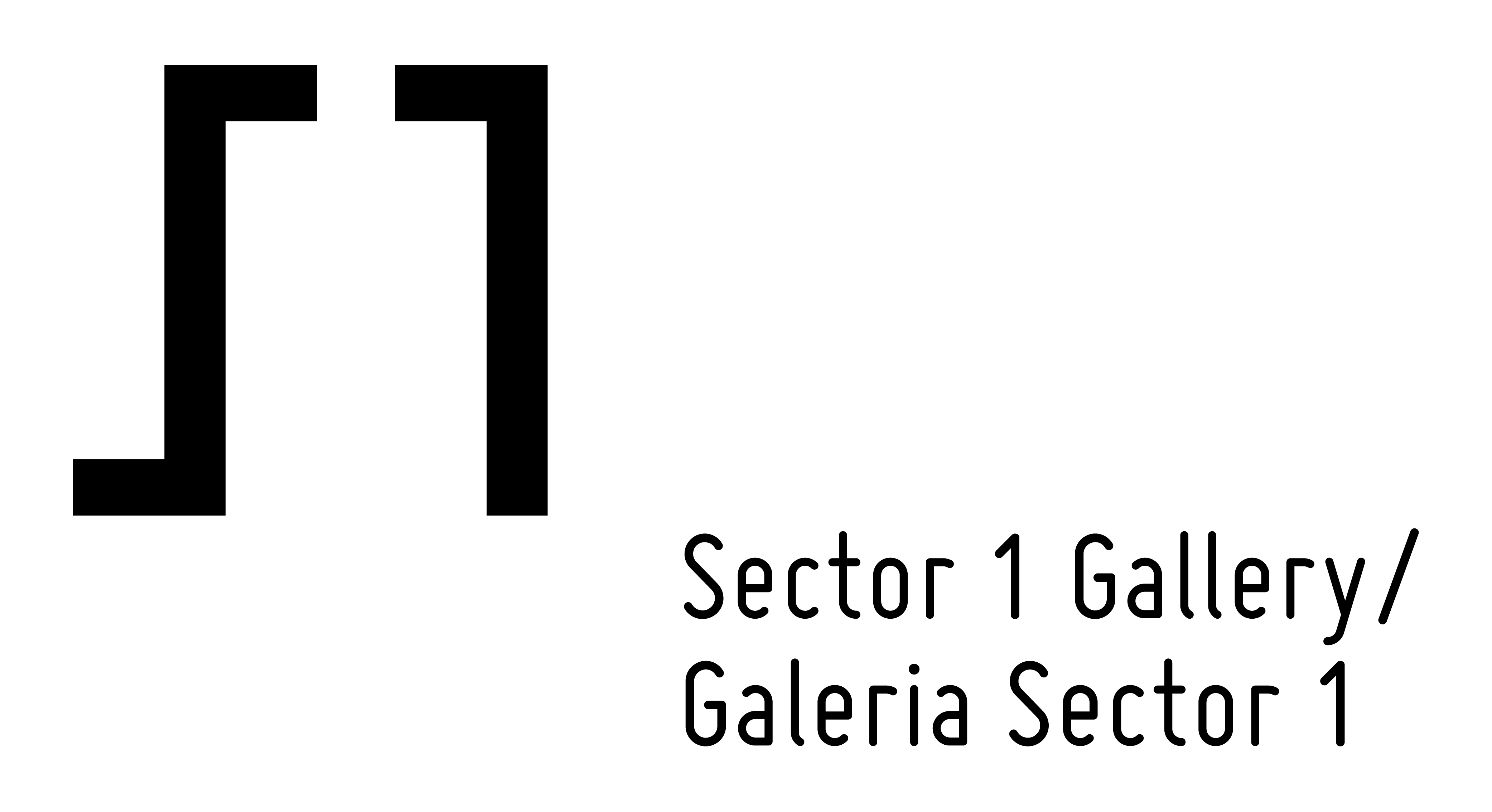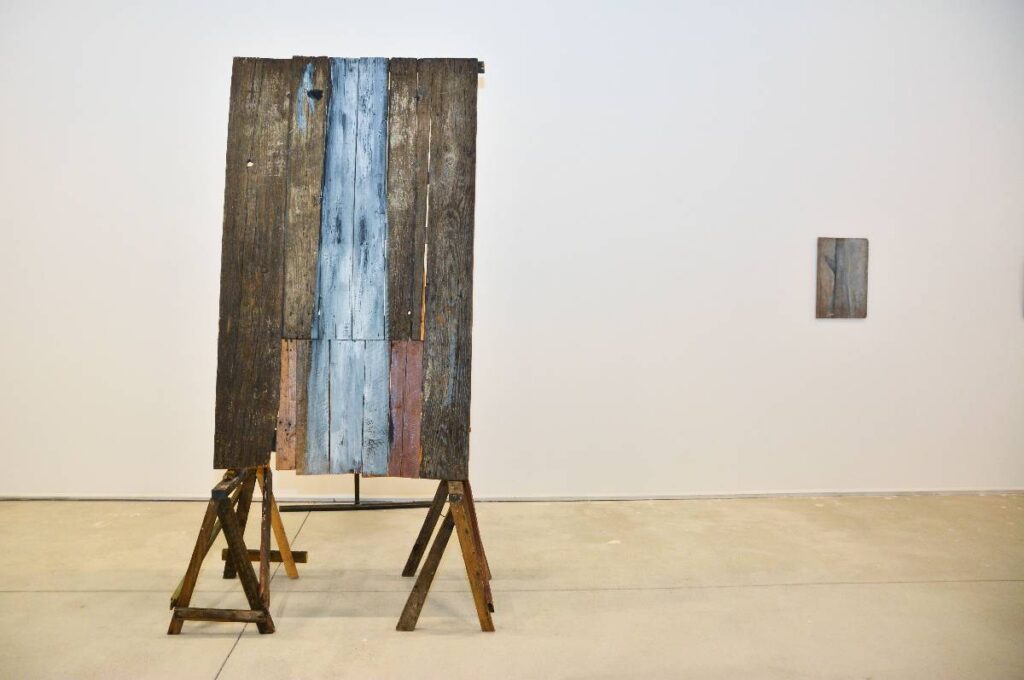SICCUM
12 July 2017 – 14 January 2018
Artist: Lucian Popăilă
Location: Sector 1 Gallery
An atypical case Garbage – chamber, only two by two, strewn with dirty bags and jars, a table placed in the middle over which objects are rolling up to the wood decking, an easel like a crutch scattered over the same table, plastic sheets and dirty paper tubes. A bustle describing the remnants of hard work, a suite of operations that is tragically consumed by the destruction of any useful object. In the only tidy part of the room are wooden chassis and panels facing each other. It is difficult to imagine, here, a laboratory of an enchanting painting. I then understood that Lucian Popăilă maintains another strategy, such like an “hit and run” tactics, where the text that emerges from the creation is more important than the painted object. The pressure exerted by the room with dirty remnants determines a result to the antithesis of the circumstances: the painting done here is both clean and clear.
There are two themes proposed by Lucian Popăilă in his presentation. A first aspect is the depiction of the lantern with which God guided the Jews of Moses through the wilderness of Egypt, where here, more precisely, the representation of the light beam is drawn as a vertical trunk. The second theme is derived from the vertical of the lantern to which are added, monochrome, some organic growths in the shape of the leaf or the spine. A landscape of maximum aridity! The ambition of the painted vertical, with the rare sharp unevenness of the vegetal tubes, shifts the emphasis of the representation on the drawing and the air of the painting results as a funerary iconography.
In the painted panels, the center is privileged, where the vertical of the composition is underlined by simple gestures, high contrasts and movements of the brush, the trace of which permits us to read the trajectory of the hand between up and down building the pillars and their outgrowths. The neutral background detaches the subject through antithetical value delimitations. If the subject is painted bright or dark, the background will break away from it, aiming in the opposite direction. A simplicity of making that has as finality the construction of a painted discourse without a doubt, with undisguised appearance of the whole, a work of ideational clarity. In the midst of the crisis, the figuration remains on the “knife edge”.
The drawing registers the drastic abandonment of the details of the real, the details that biologically describe a plant placing the subject on the border with the abstract. Essentially, the ornaments are kept in L. P’s forms, as if detached from the icon, like good axes, decorating as in a church setting. The repetition of the pillars, their rough, unbearable face, of shapes that cling and confuse the eye, where they fill it with splinters and give allergies through these ragweeds like weapons, are not the easiest sight that the comfortable contemplator can receive.
The viewer needs a certain sobriety and effort in traversing the forest of vegetal poles, choosing, finally, with the sensation that the cure of a medicine has on the patient. Fasting and austerity, restraint and economy. I have associated this kind of abandonment used here with the painting of the catacomb and its dramatic way of imposing itself. It is known that the painting of the catacomb practices negligence and a strange contempt for the performance of the frescoes in the imperial villa, as a return to the pagan Antiquity of the buildings painted under Nero, or to Pompeii. It’s as if the kitchen of a black fasting enters the brilliantly nuanced space of imperial Romanism.
The catacomb painter eagerly wanted to paint with flaws, defective, so that something else would be important in his painted text. An atypical case for that era that will not escape as a model for our artist. In order to put a brake on the emancipation of drawing, like artists who, aware of the overflow of their virtuosity, damage their working hand, considering it a burden in the success of painting. Lucian Popăilă paints his poles with the speed specific to the fresco technique, where the short interventions of the brush, economically applied, are advantageous, as in a duel of the sword-brush with the fresco panel. Consequently, he takes advantage of poor rhetoric by giving up damaged signs and artifacts, effects and excesses of painting.
We told ourselves that the ideogram and the symbolic attribute characteristic of the church representations are taken over in the garbage workshop of our painter in order to oppose the notorious values of the artists from Cluj. Domestic austerity will replace lush voracity, the harshness of the drawing will take the place of moral decay, the PFL panel will boycott the refined Belgian canvas, the monotony of the archetype will contrast the free movements of the favorite themes of the Cluj School.
Looking at Lucian Popăilă’s paintings and their environment, it is clear that they are made as an antidote to the trend of contemporary art. Therefore, we believe that his talent also lies in the efficiency with which he chooses his painted theme, as if preparing the subversive dynamics of some banal inanimate things. Detached from the exercise of freely and impetuously made forms, the project proposed today, the exhibition, claims a new path in the imaging laboratory of our painter. The recorded gain consists, beyond the novelty of the project, in the addition of artistic maturity.
November 2017, Bogdan Vlăduță
In the painted panels, the center is privileged, where the vertical of the composition is underlined by simple gestures, high contrasts and movements of the brush, the trace of which permits us to read the trajectory of the hand between up and down building the pillars and their outgrowths. The neutral background detaches the subject through antithetical value delimitations. If the subject is painted bright or dark, the background will break away from it, aiming in the opposite direction. A simplicity of making that has as finality the construction of a painted discourse without a doubt, with undisguised appearance of the whole, a work of ideational clarity. In the midst of the crisis, the figuration remains on the “knife edge”.
The drawing registers the drastic abandonment of the details of the real, the details that biologically describe a plant placing the subject on the border with the abstract. Essentially, the ornaments are kept in L. P’s forms, as if detached from the icon, like good axes, decorating as in a church setting. The repetition of the pillars, their rough, unbearable face, of shapes that cling and confuse the eye, where they fill it with splinters and give allergies through these ragweeds like weapons, are not the easiest sight that the comfortable contemplator can receive.
The viewer needs a certain sobriety and effort in traversing the forest of vegetal poles, choosing, finally, with the sensation that the cure of a medicine has on the patient. Fasting and austerity, restraint and economy. I have associated this kind of abandonment used here with the painting of the catacomb and its dramatic way of imposing itself. It is known that the painting of the catacomb practices negligence and a strange contempt for the performance of the frescoes in the imperial villa, as a return to the pagan Antiquity of the buildings painted under Nero, or to Pompeii. It’s as if the kitchen of a black fasting enters the brilliantly nuanced space of imperial Romanism.
The catacomb painter eagerly wanted to paint with flaws, defective, so that something else would be important in his painted text. An atypical case for that era that will not escape as a model for our artist. In order to put a brake on the emancipation of drawing, like artists who, aware of the overflow of their virtuosity, damage their working hand, considering it a burden in the success of painting. Lucian Popăilă paints his poles with the speed specific to the fresco technique, where the short interventions of the brush, economically applied, are advantageous, as in a duel of the sword-brush with the fresco panel. Consequently, he takes advantage of poor rhetoric by giving up damaged signs and artifacts, effects and excesses of painting.
We told ourselves that the ideogram and the symbolic attribute characteristic of the church representations are taken over in the garbage workshop of our painter in order to oppose the notorious values of the artists from Cluj. Domestic austerity will replace lush voracity, the harshness of the drawing will take the place of moral decay, the PFL panel will boycott the refined Belgian canvas, the monotony of the archetype will contrast the free movements of the favorite themes of the Cluj School.
Looking at Lucian Popăilă’s paintings and their environment, it is clear that they are made as an antidote to the trend of contemporary art. Therefore, we believe that his talent also lies in the efficiency with which he chooses his painted theme, as if preparing the subversive dynamics of some banal inanimate things. Detached from the exercise of freely and impetuously made forms, the project proposed today, the exhibition, claims a new path in the imaging laboratory of our painter. The recorded gain consists, beyond the novelty of the project, in the addition of artistic maturity.
November 2017, Bogdan Vlăduță
Looking for more?
Address
Băiculești 29 Street, District 1, 013193, Bucharest, Romania
Opening Hours
Tuesday – Saturday, 2 – 7 PM
Sunday – Monday, by appointment only
Newsletter
Sign up to receive the latest news on the gallery’s artists
Sector 1 Gallery © 2023. All Rights Reserved.
Privacy Policy

